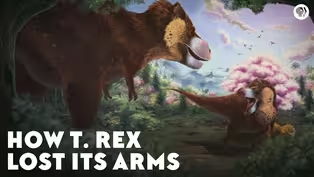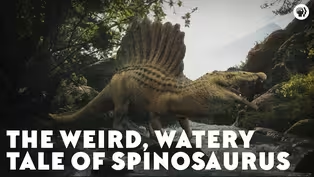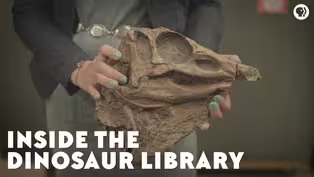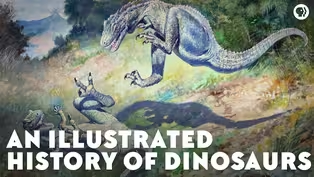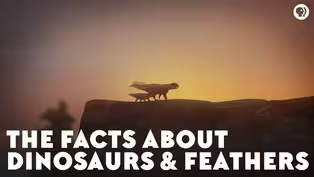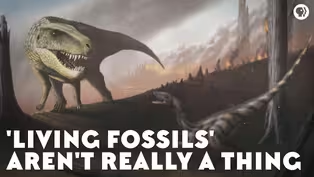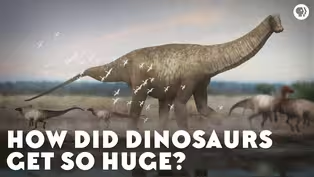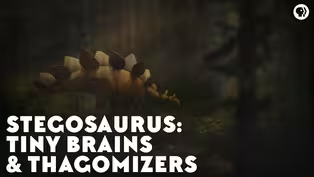
What Colors Were Dinosaurs?
Season 1 Episode 5 | 5m 2sVideo has Closed Captions
We know a lot about dinosaurs but there’s one question that has plagued paleontologists..
We know a lot about dinosaurs but there’s one question that has plagued paleontologists for decades: what color were they?
Problems playing video? | Closed Captioning Feedback
Problems playing video? | Closed Captioning Feedback

What Colors Were Dinosaurs?
Season 1 Episode 5 | 5m 2sVideo has Closed Captions
We know a lot about dinosaurs but there’s one question that has plagued paleontologists for decades: what color were they?
Problems playing video? | Closed Captioning Feedback
How to Watch Eons
Eons is available to stream on pbs.org and the free PBS App, available on iPhone, Apple TV, Android TV, Android smartphones, Amazon Fire TV, Amazon Fire Tablet, Roku, Samsung Smart TV, and Vizio.
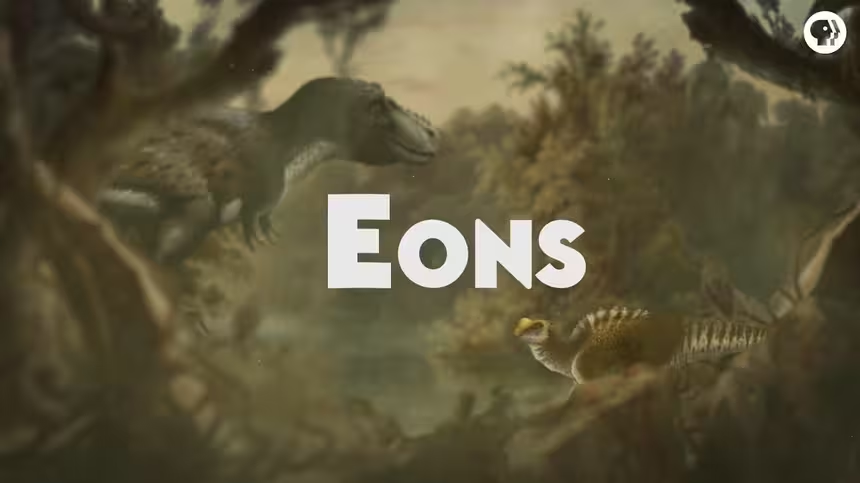
Welcome to Eons!
Join hosts Michelle Barboza-Ramirez, Kallie Moore, and Blake de Pastino as they take you on a journey through the history of life on Earth. From the dawn of life in the Archaean Eon through the Mesozoic Era — the so-called “Age of Dinosaurs” -- right up to the end of the most recent Ice Age.Providing Support for PBS.org
Learn Moreabout PBS online sponsorshipMore from This Collection
Video has Closed Captions
Tyrannosaurus rex had tiny arms. How did this happen, and why did it keep them? (6m 54s)
The Weird, Watery Tale of Spinosaurus
Video has Closed Captions
In 1912, a fossil collector discovered the world’s only known semi-aquatic dinosaur. (7m 28s)
Video has Closed Captions
We talk to Amy Atwater, Collections Manager at the Museum of the Rockies. (7m 19s)
An Illustrated History of Dinosaurs
Video has Closed Captions
Our image of dinosaurs has been constantly changing since naturalists started studying the (12m 20s)
The Facts About Dinosaurs & Feathers
Video has Closed Captions
Dinosaurs have been found with some sort of fluff or even full-on plumage. (10m 1s)
Living Fossils' Aren't Really a Thing
Video has Closed Captions
Even the most ancient-looking organisms show us that evolution is always at work. (5m 5s)
How Did Dinosaurs Get So Huge?
Video has Closed Captions
Creatures as tall as a five-story buildings shook the Earth. (5m 42s)
Stegosaurs: Tiny Brains & Thagomizers
Video has Closed Captions
If you take it as a given that extinct dinosaurs were all weird and wonderful, then you go (4m 49s)
Providing Support for PBS.org
Learn Moreabout PBS online sponsorshipOK, we know a lot about dinosaurs -- like how big they were, what they ate, and even how quickly they moved.
But there's one question that has plagued paleontologists for decades: What color were dinosaurs?
It might sound superficial, but trust me, it is not.
Because until we understand their coloration, we'll never be able to fully imagine dinosaurs.
We won't know what they really looked like, of course.
But we also won't be able to study things like camouflage or display behavior.
And we will never know the full extent of just how wrong the Jurassic Park movies are!
Thankfully, in recent years, a more complete picture of dinosaurs has come into focus -- and it is in technicolor.
When you picture a dinosaur, the colors that come to mind probably vary, depending on how old you are.
For much of the 20th century, for instance, dinosaurs were always depicted in drab colors: gray and green and brown.
That's because, back then, most experts thought that dinosaurs behaved like overgrown lizards, so they probably looked like that too.
Starting in the 1970s, dinos started to be portrayed as having things like spots, stripes, and flashy colors.
But not a lot of that was actually based on science.
Then came a major breakthrough from an unexpected place.
It wasn't a dinosaur, but a fossil squid.
In 2006, while a graduate student at Yale, paleontologist Jakob Vinther was studying a fossil squid with preserved ink sacs.
Those are the little organs where squids store their defensive inks.
And when Vinther studied them under a microscope, he saw that the sacs were filled with tiny spheres.
Other paleontologists had seen these little blobs before, but they thought they were just fossilized bacteria.
But to Vinther's eye, they looked like special structures that help give animals color -- melanosomes.
If you've heard of these things before, it's because ... YOU HAVE THEM!
Lots of animals do!
Melanosomes are responsible for all of your body's coloration, from your skin to your eyes to your hair.
Each melanosome contains some type of melanin which is a natural pigment.
And based on their density and distribution, they can create different colors!
Now, I know what you're wondering: What in the name of Charles R. Knight does a Jurassic squid have to do with dinosaurs?
Well, you know what else has melanosomes?
Feathers.
Experts can look at the feather of a living bird, like a cardinal or a crow, and see what kinds of melanosomes make that feather's color.
For example, long, skinny melanosomes make black and gray, like the black you find around cardinals' eyes.
But if melanosomes are short and round, they make reddish colors, like what you see on red tail hawks.
This information can then be used as a template for studying ancient animals.
So living dinosaurs are basically the color key to extinct dinosaurs!
In 2010, this idea was put to the test in a place that's famous for its abundant fossils of feathered dinosaurs: China.
There, a team of Chinese and British scientists studied what might be one of the most adorable dinosaurs ever -- the chicken-sized Sinosauropteryx.
Sinosauropteryx was the first non-avian dinosaur to be discovered with structures of feather-like fluff, back in 1996.
And after studying the melanosomes found in that fuzz, researchers determined that Sinosauropteryx was ... ginger!
Its downy coat was apparently reddish brown over most of its body.
But, its tail was a little different - alternating between light and dark bands, giving it some extra flair.
Vinther and his colleagues used this same technique to reconstruct the plumage of another feathery, pigeon-sized dinosaur called Anchiornis And it turned out, this dinosaur looked kind of like a ... punk rock magpie?
... mostly black and white on its wings and legs, with a splash of red on its top.
After this, the colors of more dinosaurs were soon revealed.
The four-winged Microraptor?
It had dark, iridescent plumage, kinda like a raven.
And one specimen of the little horned dinosaur Psittacosaurus was even found to have melanosomes in its skin, revealing that the dino was dark on top and light underneath.
Pretty cool, right?
As long as a dinosaur is preserved with feathers, or some other structure that keeps melanosomes intact, scientists can figure out their basic colors!
Now, this is all awesome and exciting.
But these discoveries are about a lot more than just what dinosaurs looked like.
They can also tell us about how they lived.
For example, in birds, we know that feathers aren't just used for flight -- they're also an important part of display behavior.
So, little Sinosauropteryx probably didn't have a banded tail just by chance.
Its flashy pattern tells us that this dinosaur may have had something to say to other members of its species, like that he wanted to claim his territory, or show off how fit he was for the ladies.
And the pattern found on Psittacosaurus -- dark-on-top and light below -- is a common phenomenon seen in lots of modern animals.
It's called countershading, and it would have helped this little herbivore blend in while walking through the sun-dappled forest.
Thanks to these developments, experts are beginning to uncover the colors of many other feathered dinosaurs, and new types are being found all the time!
So now we can start answering that question that's been bugging us for so long.
And memo to Hollywood!
If you're planning on having a Sinosauropteryx in Jurassic World 2, now you know what color it was!


- Science and Nature

A documentary series capturing the resilient work of female land stewards across the United States.












Support for PBS provided by:

